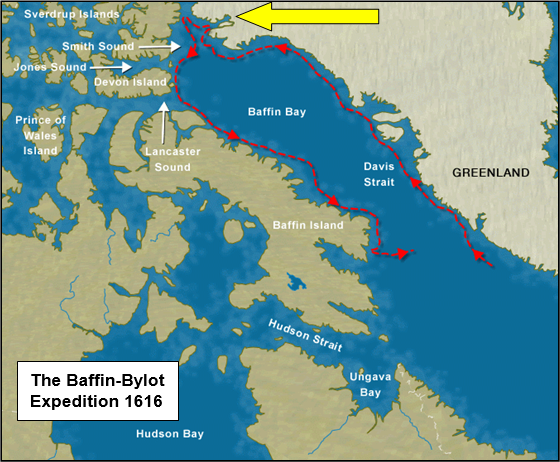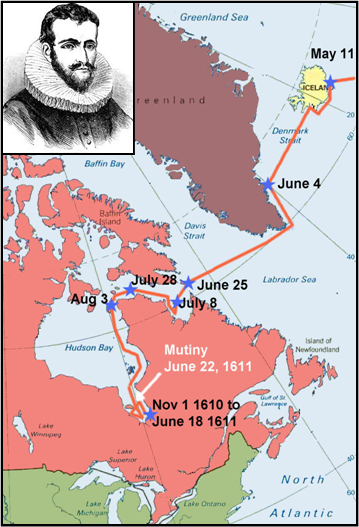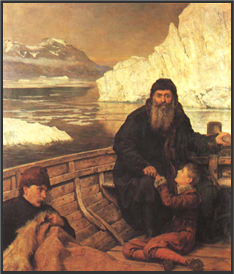


HENRY HUDSON c1565 -
Acknowledgements
Map (Canada): licensed under Creative Commons – ps79q.wikispaces.com. Hudson (inset): possible portrait, date and artist unknown, illustration from The Cyclopaedia of Universal History by the American historian John Clark Ridpath (1840-
Including:
William Baffin

 xxxxxInx1616, five years after Hudson’s tragic end, another experienced English explorer, William Baffin (1584-
xxxxxInx1616, five years after Hudson’s tragic end, another experienced English explorer, William Baffin (1584-
xxxxxEarlier, in 1612, Baffin served as chief pilot on the sailing ship Patience during an expedition in search of the Northwest passage, and in 1615, after commanding a whaling fleet near Spitsbergen in Norway, he served under Bylot aboard the Discovery in a voyage to Hudson Bay. After his visit to Baffin Bay in 1616, he worked for the East India Company, making surveys of the Persian Gulf and Red Sea. In 1622, on his final voyage to the Middle East, he was killed during an Anglo-
xxxxxIncidentally, it appears that Baffin was the first navigator to try to determine longitude by making observations of the moon. Apart from the Bay, Baffin Island, the fifth largest island in the world, is also named after him. ……
 xxxxx…… In honour of his achievements, Baffin had a rose named after him. The William Baffin Rose was bred in Canada in 1974 and introduced there in 1983. But he does not bloom alone! Amongst others included in this Canadian Explorer series of roses are George Vancouver, John Cabot, Martin Frobisher and Henry Hudson.
xxxxx…… In honour of his achievements, Baffin had a rose named after him. The William Baffin Rose was bred in Canada in 1974 and introduced there in 1983. But he does not bloom alone! Amongst others included in this Canadian Explorer series of roses are George Vancouver, John Cabot, Martin Frobisher and Henry Hudson.
xxxxxIt was in 1616, five years after Hudson’s disappearance, that another English explorer, William Baffin (1584-
xxxxxAfter two unsuccessful attempts to find a north-
 xxxxxIt was in the years 1607 and 1608 that the English explorer Henry Hudson, commissioned by the English Muscovy Company and sailing in the Hopewell, made two unsuccessful attempts to find a north-
xxxxxIt was in the years 1607 and 1608 that the English explorer Henry Hudson, commissioned by the English Muscovy Company and sailing in the Hopewell, made two unsuccessful attempts to find a north-
xxxxxIn 1610, having been commanded to serve only the country of his birth, he returned to North America in the Discovery, sailing again on behalf of the English Muscovy company, but with the additional support, this time, of the English East India Company. He entered the Hudson Strait and spent three months exploring the eastern area of what is now called Hudson Bay (see map). It was here, however, that, his ship became icebound and, following a particularly harsh winter and a severe lack of food, some of his crew mutin ied. In June 1611, during the homeward voyage, they turned him, his son, and seven others adrift in a small boat (illustrated). They were never seen again.
ied. In June 1611, during the homeward voyage, they turned him, his son, and seven others adrift in a small boat (illustrated). They were never seen again.
xxxxxIncidentally, nothing is known of Hudson's early life, but the 1585 Arctic expedition by the English navigator John Davis was planned in the home of a Thomas Hudson of Limehouse, London. It is possible that the young Henry was a relation of this Hudson and was present when the voyage was being planned. This would certainly account for his lifelong interest in Arctic exploration.
J1-


